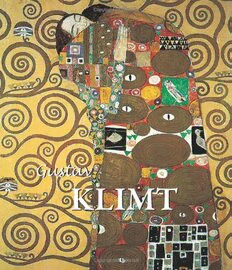Table Of ContentKlimt
Text: Jane Rogoyska and Patrick Bade
Page 4:
Photograph of Gustav Klimt
Layout:
Baseline Co Ltd
61A-63A Vo Van Tan Street
4thFloor
District 3, Ho Chi Minh City
Vietnam
Library of Congress Cataloging-in-Publication Data
Rogoyska, Jane.
Klimt, 1862-1918 / [authors, Jane Rogyska, Patrick Bade].
p. cm.
Includes index.
ISBN 978-1-84484-590-3 (hardcover)
1. Klimt, Gustav, 1862-1918. 2. Artists--Austria--Biography. I. Klimt, Gustav, 1862-1918.
II. Bade, Patrick. III. Title.
N6811.5.K55R64 2011
709.2--dc22
[B]
2011002004
© Confidential Concepts, worldwide, USA
© Parkstone Press International, New York, USA
All rights reserved. No part of this publication may be reproduced or adapted without the
permission of the copyright holder, throughout the world. Unless otherwise specified, copyright
on the works reproduced lies with the respective photographers, artists, heirs or estates. Despite
intensive research, it has not always been possible to establish copyright ownership. Where this
is the case, we would appreciate notification.
ISBN: 978-1-78042-241-1
2
“As the committee must be aware, a group of artists within the
organization has for years been trying to make its artistic views felt.
These views culminate in the recognition of the necessity of bringing
artistic life in Vienna into more lively contact with the continuing
development of art abroad, and of putting exhibitions on a purely
artistic footing, free from any commercial considerations; of thereby
awakening in wider circles a purified, modern view of art; and lastly,
including a heightened concern for art in official circles.”
3
4
Biography
1862: Birth of Gustav Klimt in Baumgarten, near Vienna. His father, Ernest Klimt was a gold
engraver and his mother, Anna Finster, was a lyric singer.
1876: He enters the School of Arts and Sciences at the Museum of Art and Industry in Vienna.
He takes painting classes from Professor Laufberger.
1877: To make money, he takes photographic portraits.
1883: Klimt gets his degree from The School of Arts and Sciences in Vienna. He opens a
workshop with one of his brothers (Ernst Klimt) and another painter (Franz Matsch).
They do several works together, some of which are frescos for theatres.
1885: The group decorates the Hermès villa and the National Theatre of Fiume.
1887: The Municipal Consul of Vienna asks Klimt to paint an interior scene of the ancient
imperial theatre.
1888: Klimt completes the painting of the Imperial Theatre. He receives the Gold Cross of Merit
for the accomplishment.
1889: Klimt begins the decoration of the staircases at the Museum of Art History in Vienna. He
receives the Imperial Prize, awarded for the first time to him.
1890: Klimt becomes a member of the group for artists in the plastic arts in Vienna. With his
brother Ernst and Franz Matsch, he is awarded “the highest recognition” for the decoration
of the Museum of Art History.
1892: His father and his brother Ernst die.
1893: Klimt takes a trip to Hungary where Duke Esterhazy asks him to paint the Totis theatre.
1894: The Minister of Education asks Klimt and Matsch to do the Faculty Paintings on the
ceiling of the hallway in the University of Vienna.
1897: Klimt leaves the association for artists in the plastic arts in Vienna. Joseph Maria
Olbrich, Josef Hoffmann and Klimt found the Vienna Secession and Klimt becomes the
Succession’s president. Olbrich, Hoffman and Klimt work on the paintingsPhilosophy
andMedicinefor the University.
5
6
1898: First exposition of the Vienna Secession and the founding of its magazine: Ver Sacrum.
The same year, Klimt becomes a member of the International Society of Painters,
Sculptors and Engravers in London and is nominated a corresponding member of the
Munich Succession.
1899: He finishes the decoration for the Music Room at the Dumba palace with his paintings
Schubert at the Pianoand Music.
1900: He exhibits, next to landscape paintings, his unfinished Philosophy, in the Secession’s
house and the painting provokes violent protests. However, he receives a gold medal for
this painting at the Universal Exposition in Paris.
1901: The exhibition of Medicinereceives criticism from the press.
1902: The Secession has an exhibition with a presentation of the Beethovenfrieze.
1903: A collective exhibition at the Secession with eighty works by Klimt. Klimt takes a trip to
Ravenne and Florence.
1905: The order for the Faculty Paintings is cancelled and then bought back. Klimt retires from
the Secession and leaves for Berlin where he participates in the Alliance of German
Artists Exhibition with fifteen paintings and he receives the “Villa Romana” Prize.
1906: Foundation of the Alliance of Austrian Artists (Klimt becomes president of the Alliance in
1912). He becomes an honorary member of the Royal Bavarian Academy of the
Decorative Arts in Munich.
1907: He finishes the Faculty Paintings and exhibits them in Vienna and Berlin.
1910: He participates in the Venice Biennial.
1911: Participates, with eight paintings, at the International Exhibition of Art in Rome and
receives the first prize for Death and Life.
1912: Klimt becomes president of the Alliance of Austrian Artists in Rome.
1917: Klimt becomes an honorary member of the Academy of the Decorative Arts in Vienna
after the chair had been refused four times by the minister.
1918: On 11 January, Klimt suffers from a stroke in his Viennese apartment and dies on
6February, leaving a number of unfinished works.
7
am not interested in myself as a subject for
‘I
painting, but in others, particularly
women...’ Beautiful, sensuous and above all
erotic, Gustav Klimt’s paintings speak of a
world of opulence and leisure, which seems
aeons away from the harsh, post-modern
environment we live in now.
Gustav Klimt
photograph
8
9
The subjects he treats – allegories, portraits,
landscapes and erotic figures – contain
virtually no reference to external events, but
strive rather to create a world where beauty,
above everything else, is dominant. His use of
colour and pattern, profoundly influenced by
the art of Japan, ancient Egypt, and Byzantine.
Male Nude Walking Facing Right
1877-79
pencil, 43 x 24 cm
10

